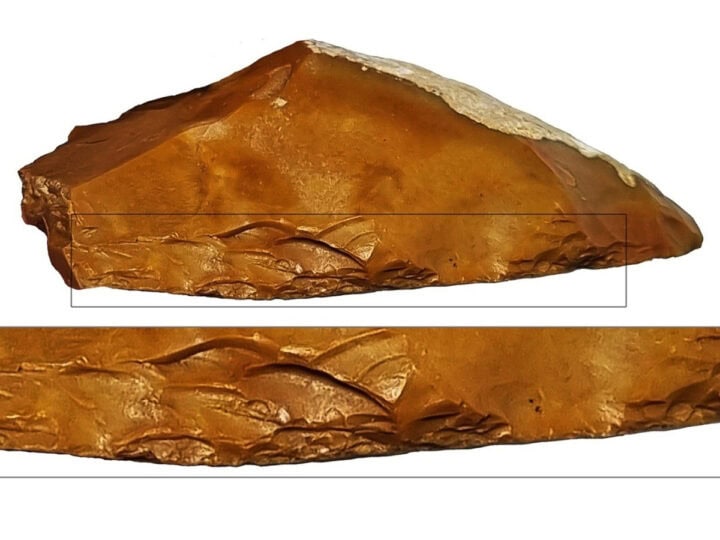
Under the hot sun at Tel es-Safi in southern Israel — the Philistine city of Gath — archeologists have been puzzling over life in the Iron Age city and how it was plundered and destroyed by some invading force hundreds of years before the common era.
“It was like a mini-Pompei, a frozen record in a moment of time,” says Prof. Steve Weiner, director of the Kimmel Center for Archeological Science at the Weizmann Institute in Rehovot.
Kimmel’s unique onsite laboratory helps archeologists piece together the events of the destruction.
“It has changed the whole paradigm of how to solve archeological problems in the field using both what you see by eye and what you can reveal with instrumentation — the microscopic archeological record, from sub-millimeter scale down to the atomic level,” he tells ISRAEL21c. “There’s a lot of information embedded in this record.”
With the help of the lab, the Weizmann team together with the archeology team from Bar-Ilan University determined that the destruction was not one cataclysmic event in the late ninth century BCE, but more likely occurred over decades, with periods of erosion and abandonment.
“So what people assumed was instantaneous was not that at all,” says Weiner. “You can only understand that by getting into all the microscopic details.”
The mobile lab is a critical part of a holistic “microarcheology” approach that puts natural scientific methods to work in the field.
Dig less, find out more
As Weiner describes in Microarchaeology: Beyond the Visible Archaeological Record (Cambridge, 2010), much information can be extracted microscopically from excavated materials such as ceramic, bone, rock, ash, plants and sediment.
“The trend in archeology is to excavate less but to extract more information from the archeological record,” he writes.
Beginning this process in the field is best, and the Weizmann team was able to pioneer such an approach thanks in part to the small size of Israel — a country Weiner calls “one huge archeological site.” Scientists can set up shop at a dig for weeks at a time and still be close to their home institution.
“From the late 1980s, our idea was to address analytical investigation at the site and to get information in real time, and that’s really important in excavation,” Weiner explains. “If you sample something and it turns out to be interesting, you can’t achieve much if you have to wait to analyze it, as the excavation has proceeded and the feature is destroyed.”
The field lab consists of portable infrared spectrometers and a portable petrographic microscope at the excavation site, while another lab at the base camp can facilitate more intricate analyses of the day’s finds. By the following morning, the results are ready and can be used to decide on the day’s excavation strategy.
“The micro record requires much training in natural sciences to interpret results, and also in archeology. This indeed reflects the training of the senior members of the center, Dr. Ruth Shahack-Gross and Dr. Elisabetta Boaretto.”
Training foreign students
The Kimmel Center collaborates on major digs supervised by Prof. Israel Finkelstein from Tel Aviv University at Megiddo, Prof. Aren Maeir of Bar-Ilan University at Tel es-Safi and Prof. Daniel Masters from Wheaton College in Illinois, who excavates at Ashkelon.
In addition, graduate students and academics from abroad often get training at Kimmel. The most recent visitors were from California, Minnesota and Bogota, Colombia.
“People in the field all over the world are paying attention to this,” says Weiner. “What we offer is very unusual. I know no other place that has similar setup. There are other field labs, but this type of integration of field and lab is quite unique.”
Discovering Gath
Maeir tells ISRAEL21c that the on-site microarcheology lab made a huge difference in his team’s comprehension of what was unearthed at Tel es-Safi.
“In the past, the science was done after you found something cool in the excavation,” he explains. “Here, the idea is to have perspectives on the spot and some of the scientific analysis in the field or that evening in the base lab. That way, we could identify things we wouldn’t have identified otherwise, understand what we’re excavating, save the right materials for analysis and change our excavation strategy accordingly. It turns it into a collaborative effort, not just ‘plain vanilla’ archeology.”
Having access to a wide battery of scientists from different fields, each contributing their expertise, led to published papers on topics the archeologists wouldn’t have noticed without the archaeological scientists.
Maeir recalls that in one dig at Tel el-Safi, excavators saw signs of metal and stopped to have Kimmel experts check it out.
“We couldn’t tell for sure by eye, but with the help of scientific analysis we realized we had excavated a metal production area for iron and bronze — the earliest found up to now in Philistia,” says Maeir. “Without metallurgists on site, it could be that this evidence would have gone unnoticed. The combination of equipment and different perspectives allows for an integrated perspective on the past.”
In addition to investments from the Weizmann Institute, the Kimmel Center is financed by a three million euro European Research Council grant and two grants from the Israel Science Foundation (www.isf.org.il/english).
















